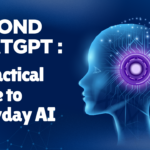AI. Artificial Intelligence. two words that are on everyone’s lips, from the CEO of Google to a poor school student doing their homework. Whether you know it or not, AI is a part of your daily life, unless you’ve been living under a rock, so you probably wouldn’t be reading this blog post! But many people don’t know much about AI, except that it’s a homework helper. So, what really is AI? Which AI to use? And most importantly, have you been using it wrong all your life? Well, that’s what I’ll be throwing some light upon in this article.
I’ve included a cheatsheet of which AI to use for what purpose at the end too! So, without further ado, let’s jump right into it.
PT1: What is AI?
Artificial intelligence , in the simplest of terms, is a system, or software, that can mimic human cognitive abilities, i.e., it can do tasks that generally require human thinking. AIs are engineered to learn, reason, solve problems, and make decisions. AI does come in many forms, and is categorized based on its capabilities, functionality, or learning methods. I won’t go into functionality, as it’s a very broad and complex category, so I will just display the other 2 segregations, for simplicity’s sake.
- Capabilities:
- Narrow AI
The Current type of AI. It’s made of a specific set of tasks, nothing more, nothing less. Some of them are more versatile, while some are not. I’ll go through some examples soon.
- Strong AI
A theoretical AI which is as smart as humans. It should be able to understand, learn, and act like a human. While it is unlikely to be made soon, it’s the goal that researchers are working towards. (Don’t think of I, Robot, please)
- Learning methods:
- Supervised learning
The AI is trained using labeled data, where the desired output is given by known inputs. It maps inputs to outputs.
- Unsupervised learning
It’s trained without supervision, and attempts to find patterns, structures, or relationships with data, without human intervention.
- Deep Reinforcement Learning
The AI learns to make decisions with no human intervention. It learns by interacting with an environment, and learns by getting rewards for good behavior, and punishments for bad behavior.
- Semi-Supervised Learning
A combination of supervised and unsupervised learning, where the model is trained using a dataset with a small amount of labeled data, and a much larger amount of unlabeled data.
PT2: Which AI should I use?
Like I said above, AIs aren’t all-powerful, and one AI can’t do all your work! Most people are under the impression that the run-of-the-mill ChatGPT can do everything you need, but that’s inaccurate.
Before we dive in, let me make it clear that NONE of the available AIs can do the below:
- # Have genuine understanding
- # Have a consciousness, or experience
- # Cannot truly be creative, as it created based on the datasets provided
- # Show emotions
- # Have morals or ethics
I’ll talk a little about this in the end, and let me tell you, it’s VERY IMPORTANT.
So, let’s talk about what AI you need to use for what purpose.
- ChatGPT
ChatGPT is probably the most famous AI right now, having a market share of around 81%, as of April 2025. However, most of the ways it is used are not its intended use cases, therefore it is rather inaccurate.
ChatGPT is intended to be an AI for quasi-human conversations, to understand the “informal” language, or “spoken language.” It can summarize concepts, provide some degree of information, generates content, both text based, and image based (as I’m sure you’ve tried, with the Ghibli Trend). It’s also used for creative writing, code debugging, etc.
HOWEVER, you can’t expect 100% Accurate information from ChatGPT, especially the more advanced the topic is. You also cannot receive reliable advice on legal, health or financial matters.
A quick note: ChatGPT for some reason has 3 image generation models, Dall-E, Sora, and ChatGPT. ChatGPT is slow, but is the most realistic, and Dall-E is fast but unrealistic. Sora is just somewhere between.
My take: ChatGPT is an excellent tool if you want to have a conversation, generate something, or get help with some technical troubles (It is awesome with technical). However, don’t try to discuss advanced topics, or ask it about some data in general.
- Perplexity
An AI that is quickly gaining footage, It’s one of the most factually accurate ones. It also has multiple functions, such as deep research, which scours much of the web, taking up to 30 minutes, to provide you with the most reliable and comprehensive result possible. However, using it for daily conversations, with informal language, aren’t as natural as with ChatGPT. Its main intended usage is to be used as a more powerful search engine, providing just what you need, in the most accurate manner possible. Still, it’s not the most interesting to talk to, unless all you talk about is boring scientific theses. Also, it’s not the best when it comes to solving problems logically, too.
My take: It’s the best for research on scientific topics, but for daily conversations, or logical problem solving? Not the best.
- Google Gemini
What started off as a pure joke (Still is, especially in the AI summary in the google search engine), is now a much more powerful AI. While not the best here, it still has a respectable market share. It’s a good AI for semi-creative literary usage, and for any literary and philosophical questions, and is quite good for talking to. Using the PRO version, I found that its excellent for coding, especially bug fixing.
However factual information is a hit and miss, especially with the Generative AI Summary in the search engine.
My take: Great for literature, any textual creativity and semi-fun conversations. Facts? Not so much.
- DeepSeek
Something really making rounds around the internet, DeepSeek is meant to be a Reasoning bot, which means it can sort of think organically. HOWEVER, chatGPT launched its own version, and perplexity simply uses DeepSeek R1.
As a stand-alone AI, it’s not the most useful. It’s smart when it comes to reasoning, so its logic is top-notch, but conversations are dry and boring. Also, the amount of censorship is FAR higher than any other AIs on this list.
My Take: Not my favorite AI here, but it does its intended purpose perfectly. Prefer using it through Perplexity Though.
- Microsoft Copilot
The BEST Technical support AI on this list. Anything technical- this can help you with it effortlessly. Heck, I installed and debugged my entire PC’s linux using copilot. It’s also great for code-fixing and debugging too, and its factually accurate (like perplexity, it aggregates data from websites) But, its overly polite and Robotic for everyday conversations, like perplexity. However, it’s logic far outstrips that of perplexity.
My Take: Great for technical support and coding, good for logic and facts, bad for basically everything else.
- Claude AI
This AI seems to me to be very tailor made. It advertises its use as a wide range of applications, but in practice, it seems to be solely for coding. It’s coding and debugging skills far outreach that of any other AI on the list, so likewise its logic is also off the charts. But use it for anything else and it doesn’t prove to be as reliable as the others.
My Take: Perfect for Coding, perfect for nothing else. If you need a coding bot, look no further.
- Grok AI, by X
Saved this one for last because I had far too much fun playing with this one. I call this one a memebot, because while it’s not BAD at anything, its not GOOD at them either. ONE thing it’s too good at, is that its NLP (Natural Language Processing) Model. It feels almost natural to talk to, so conversations are fun. Also, it’s the most lightly censored bot, so talking to it about sensitive matters are much easier.
My Take: Great Bot for talking to, but I prefer other bots on the list for other purposes.
MY CHEATSHEET
So, you’ve either skipped everything, and jumped here, or read the whole thing. Either way, the most important part lies here. What AI to use, for which purpose. So, Let’s go. I’ve given my top 3 for each, in order.
Coding:
- Claude AI
- Google Gemini PRO
- Microsoft Copilot
Creative Writing
- Google Gemini
- ChatGPT
- Grok AI
Homework help
- Perplexity
- Google Gemini
- ChatGPT
Tech Support
- Microsoft Copilot
- ChatGPT
- Claude AI
Conversations
- Grok AI
- ChatGPT
- Google Gemini
Research
- Perplexity (DeepSeek in Perplexity)
- ChatGPT
- Microsoft Copilot
ETHICS
Ethics, something everyone skips over, but is crucial. AI does have a dark side. And there are 5 big problems with it.
- Hallucinations: That’s when AI decided to make up its own information or gives you the wrong information. So, make sure to check important information.
- Deepfakes: AI Generated media that makes it look like someone did something they didn’t do. It’s huge issue, causing trust loss, and a lot of illegal content. The problem? AI laws are not developed yet.
- Bias: AI is trained on data from the internet, and along with it comes the racism, sexism, etc. So, make sure to be careful with AIs.
- Privacy Concerns: Privacy, something that doesn’t exist with AIs. They log your data and use it to train future models. Be Aware.
- Lack of morals: AIs lack emotions, morals and ethics, so it always provides the logical answer. So, if you want an answer to a question that has emotions or ethics involved, don’t ask AI.
Keep these ethics in mind when using AI, so that you can get the most out of it without any repercussions!
So, that’s a wrap on the AI part. I could include so many more AIs, like Alexa and Siri, Character.AI, and the likes, but I decided to focus on the more “useful” and “everyday bread-and-butter” AIs. I hope this guide helps you understand AIs better, and help you choose the right AI for you. Thank you for taking the time to read my 1731 words long article, and i really hope this makes a change in your life. All the best for tackling the world, my friend!






